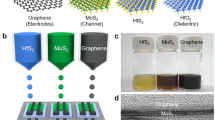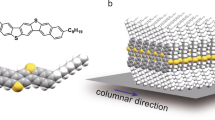Abstract
The use of single crystals has been fundamental to the development of semiconductor microelectronics and solid-state science1. Whether based on inorganic2,3,4,5 or organic6,7,8 materials, the devices that show the highest performance rely on single-crystal interfaces, with their nearly perfect translational symmetry and exceptionally high chemical purity. Attention has recently been focused on developing simple ways of producing electronic devices by means of printing technologies. ‘Printed electronics’ is being explored for the manufacture of large-area and flexible electronic devices by the patterned application of functional inks containing soluble or dispersed semiconducting materials9,10,11. However, because of the strong self-organizing tendency of the deposited materials12,13, the production of semiconducting thin films of high crystallinity (indispensable for realizing high carrier mobility) may be incompatible with conventional printing processes. Here we develop a method that combines the technique of antisolvent crystallization14 with inkjet printing to produce organic semiconducting thin films of high crystallinity. Specifically, we show that mixing fine droplets of an antisolvent and a solution of an active semiconducting component within a confined area on an amorphous substrate can trigger the controlled formation of exceptionally uniform single-crystal or polycrystalline thin films that grow at the liquid–air interfaces. Using this approach, we have printed single crystals of the organic semiconductor 2,7-dioctyl[1]benzothieno[3,2-b][1]benzothiophene (C8-BTBT) (ref. 15), yielding thin-film transistors with average carrier mobilities as high as 16.4 cm2 V−1 s−1. This printing technique constitutes a major step towards the use of high-performance single-crystal semiconductor devices for large-area and flexible electronics applications.
This is a preview of subscription content, access via your institution
Access options
Subscribe to this journal
Receive 51 print issues and online access
$199.00 per year
only $3.90 per issue
Buy this article
- Purchase on Springer Link
- Instant access to full article PDF
Prices may be subject to local taxes which are calculated during checkout



Similar content being viewed by others
References
Teal, G. K. Single crystals of germanium and silicon—basic to the transistor and integrated circuit. IEEE Trans. Electron. Dev. 23, 621–639 (1976)
Tsui, D. C., Stormer, H. L. & Gossard, A. C. Two-dimensional magnetotransport in the extreme quantum limit. Phys. Rev. Lett. 48, 1559–1562 (1982)
De Poortere, E. P. et al. Enhanced electron mobility and high order fractional quantum Hall states in AlAs quantum wells. Appl. Phys. Lett. 80, 1583–1585 (2002)
Ohtomo, A. & Hwang, H. Y. A high-mobility electron gas at the LaAlO3/SrTiO3 heterointerface. Nature 427, 423–426 (2004)
Tsukazaki, A. et al. Observation of the fractional quantum Hall effect in an oxide. Nature Mater. 9, 889–893 (2010)
Sundar, V. C. et al. Elastomeric transistor stamps: reversible probing of charge transport in organic crystals. Science 303, 1644–1646 (2004)
Briseno, A. L. et al. Patterning organic single-crystal transistor arrays. Nature 444, 913–917 (2006)
Takeya, J. et al. Very high-mobility organic single-crystal transistors with in-crystal conduction channel. Appl. Phys. Lett. 90, 102120 (2007)
Yan, H. et al. A high-mobility electron-transporting polymer for printed transistors. Nature 457, 679–686 (2009)
Rivnay, J. et al. Large modulation of carrier transport by grain-boundary molecular packing and microstructure in organic thin films. Nature Mater. 8, 952–958 (2009)
Noh, Y.-Y., Zhao, N., Caironi, M. & Sirringhaus, H. Downscaling of self-aligned, all-printed polymer thin-film transistors. Nature Nanotechnol. 2, 784–789 (2007)
Whitesides, G. M. & Grzybowski, B. Self-assembly at all scales. Science 295, 2418–2421 (2002)
Lim, J. A., Lee, H. S., Lee, W. H. & Cho, K. Control of the morphology and structural development of solution-processed functionalized acenes for high-performance organic transistors. Adv. Funct. Mater. 19, 1515–1525 (2009)
Tung, H.-H., Paul, E. L., Midler, M. & McCauley, J. A. Crystallization of Organic Compounds: An Industrial Perspective 179–205 (Wiley, 2009)
Ebata, H. et al. Highly soluble [1]benzothieno[3,2-b]benzothiophene (BTBT) derivatives for high-performance, solution-processed organic field-effect transistors. J. Am. Chem. Soc. 129, 15732–15733 (2007)
Hiraoka, M. et al. On-substrate synthesis of molecular conductor films and circuits. Adv. Mater. 19, 3248–3251 (2007)
Hasegawa, T., Hiraoka, M. & Yamada, T. Double-shot inkjet printing of donor–acceptor-type organic charge-transfer complexes: wet/nonwet definition and its use for contact engineering. Thin Solid Films 518, 3988–3991 (2010)
Sirringhaus, H. et al. High-resolution inkjet printing of all-polymer transistor circuits. Science 290, 2123–2126 (2000)
Chen, Z., Liu, M., Liu, G.-y. & Tan, L. Evaporation induced two-dimensional buckling within liquid droplet. Appl. Phys. Lett. 95, 223104 (2009)
Deegan, R. D. et al. Capillary flow as the cause of ring stains from dried liquid drops. Nature 389, 827–829 (1997)
Uemura, T., Hirose, Y., Uno, M., Takimiya, K. & Takeya, J. Very high mobility in solution-processed organic thin-film transistors of highly ordered [1]benzothieno[3,2-b]benzothiophene derivatives. Appl. Phys. Expr. 2, 111501 (2009)
Izawa, T., Miyazaki, E. & Takimiya, K. Molecular ordering of high-performance soluble molecular semiconductors and re-evaluation of their field-effect transistor characteristics. Adv. Mater. 20, 3388–3392 (2008)
Pope, M. & Swenberg, C. E. Electronic Processes in Organic Crystals and Polymers 2nd edn, 59–66 (Oxford Science, 1999)
Faltermeier, D., Gompf, B., Dressel, M., Tripathi, A. K. & Pflaum, J. Optical properties of pentacene thin films and single crystals. Phys. Rev. B 74, 125416 (2006)
Ulman, A. An Introduction to Ultrathin Organic Films, from Langmuir-Blodgett to Self-Assembly 1st edn (Academic, 1991)
deMello, A. J. Control and detection of chemical reactions in microfluidic systems. Nature 442, 394–402 (2006)
Acknowledgements
We are grateful to Nippon Kayaku for providing C8-BTBT. We thank K. Takimiya and S. Horiuchi for discussions, H. Okamoto and H. Matsuzaki for help with optical measurements, K. Kobayashi for help with the X-ray measurements, and T. Iwadate for help with atomic-force microscopy and measurements of device characteristics. The synchrotron X-ray study was performed with the approval of the Photon Factory Program Advisory Committee (no. 2009S2-003). This work was supported by the New Energy and Industrial Technology Development Organization (NEDO) through a Grant for Industrial Technology Research and also by the Japan Society for the Promotion of Science (JSPS) through its Funding Program for World-Leading Innovative R&D on Science and Technology (FIRST Program).
Author information
Authors and Affiliations
Contributions
H. Minemawari was responsible for ink fabrication, inkjet printing, microscopic observations, X-ray diffraction measurements, and measurements of the device characteristics of all the films. T.Y. prepared substrates with the wet/non-wet surface patterning, assisted in inkjet printing and X-ray diffraction measurements, and performed atomic-force microscopy and device characteristics measurements. H. Matsui guided sample preparation and inkjet printing, and conducted DFT molecular orbital calculations. J.T. assisted with X-ray diffraction measurements and performed optical anisotropic absorption measurements. S.H. assisted with optical anisotropic absorption measurements. R.C. assisted in the ink fabrication. R.K. assisted with X-ray diffraction measurements. T.H. conceptualized and directed the research project, and wrote most of the manuscript. All the authors discussed the results and commented on the manuscript.
Corresponding author
Ethics declarations
Competing interests
The authors declare no competing financial interests.
Supplementary information
Supplementary Information
The file contains Supplementary text and Supplementary Figures 1-5 with legends. (PDF 1373 kb)
Supplementary Movie 1
The movie shows a top view of the droplet deposited by the AC-IJP on top of the predefined hydrophilic area containing a protuberance, in which the growth process of single-crystal film can be observed. (MOV 3121 kb)
Supplementary Movie 2
The movie shows a top view of the droplet deposited by the AC-IJP on top of the predefined hydrophilic area with a rectangle shape, in which the growth process of polycrystalline film can be observed. (MOV 9088 kb)
Rights and permissions
About this article
Cite this article
Minemawari, H., Yamada, T., Matsui, H. et al. Inkjet printing of single-crystal films. Nature 475, 364–367 (2011). https://doi.org/10.1038/nature10313
Received:
Accepted:
Published:
Issue Date:
DOI: https://doi.org/10.1038/nature10313
This article is cited by
-
Stretchable liquid metal based biomedical devices
npj Flexible Electronics (2024)
-
Intense pulsed light annealing of solution-based indium–gallium–zinc–oxide semiconductors with printed Ag source and drain electrodes for bottom gate thin film transistors
Scientific Reports (2024)
-
Full degree-of-freedom polarization hologram by freeform exposure and inkjet printing
PhotoniX (2023)
-
Recent advances in flexible noninvasive electrodes for surface electromyography acquisition
npj Flexible Electronics (2023)
-
Wafer-scale organic-on-III-V monolithic heterogeneous integration for active-matrix micro-LED displays
Nature Communications (2023)
Comments
By submitting a comment you agree to abide by our Terms and Community Guidelines. If you find something abusive or that does not comply with our terms or guidelines please flag it as inappropriate.



